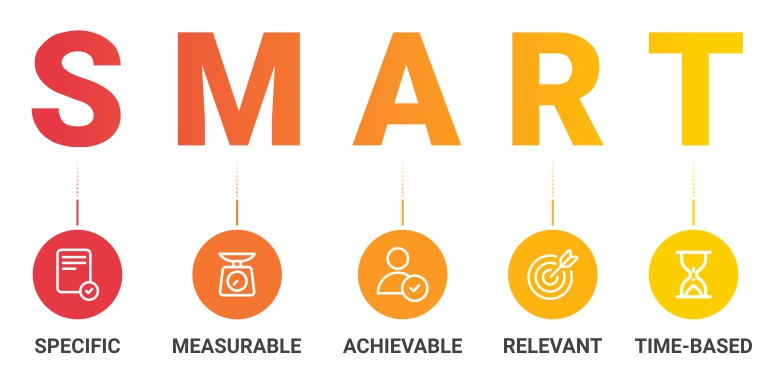Smart Goal Setting for Savings
Have you ever wondered if there’s a secret to boosting your savings?
It starts with one compelling idea: What if setting S.M.A.R.T. goals is the key to real financial progress?
Smart goal setting for savings involves crafting the right plan and fostering dedication to execute it successfully.
When contemplating =how to save money effectively, embracing =the basics of savings goals= becomes paramount.
Moreover, understanding the distinction between =short-term and long-term saving strategies= is integral to tailoring your goals to match your unique financial landscape.
The S.M.A.R.T. goals method for saving money provides a structured approach to make your financial aspirations more tangible.
The acronym S.M.A.R.T. stands for Specific, Measurable, Attainable, Relevant, and Time-based.
This outlines a comprehensive strategy to ensure that your savings objectives are well-defined, trackable, achievable, aligned with your priorities, and grounded within a specified timeframe.
Prepare for a deep dive into the secrets of the S.M.A.R.T. method as you read on and unravel its components.
Smart goal setting for savings
Are you feeling hesitant about aiming high?
Shed that fear and ask yourself: Why not set ambitious goals and start achieving them with smart goal-setting for savings?
By embracing a strategic approach, you pave the way for financial success.
Identify specific objectives that align with your aspirations, ensuring they are measurable, attainable, relevant, and time-based.
Setting ambitious yet achievable goals becomes the catalyst for substantial progress.
Whether it’s saving for a dream home, education, or retirement, the S.M.A.R.T. method empowers you to navigate the path toward financial security with confidence.
The key lies in the deliberate planning and dedication required to transform your bold aspirations into tangible, long-lasting financial accomplishments.
Applying SMART Criteria to Savings Goals
Applying S.M.A.R.T. criteria to savings goals involves a meticulous approach to financial planning.
Begin by choosing precise saving targets that fit your long-term aspirations, whether saving for a house, planning for retirement, building an emergency fund, or striving for a debt-free future.
The key is to set specific benchmarks, such as monthly saving targets, to track your progress methodically.
But here’s the question: Given your unique income and expenses, are your financial goals ambitious and realistic?
Align your savings goals with your financial situation and future aspirations to create a roadmap tailored to your unique circumstances.
Establish a clear timeline for each goal, providing a structured framework that adds a time-based dimension to your financial journey.
What are smart goals?
Understanding what SMART goals entail is pivotal for effective goal-setting.
Each component serves as a crucial guideline.
When crafting a goal, ensure it is Specific, leaving no room for ambiguity.
Make it Measurable by establishing quantifiable criteria to track progress and success.
The goal should be Achievable, considering your resources and capabilities.
Keep it Relevant by aligning it with your broader objectives and aspirations.
Finally, make it Time-bound by setting a specific timeframe for achievement, providing a sense of urgency and focus.
If the answer to these criteria is affirmative, congratulations – you’ve crafted a S.M.A.R.T. goal, setting the stage for a well-defined and achievable path to success.
So, are your goals SMART enough to propel you toward financial victory?
SMART Goals Examples for Saving Money
Are you still finding it a bit fuzzy? Let’s paint a clearer picture with a few examples.
1. Track spending to save 10 percent each month of my income
I earn $4,000 a month. In four months, I want to save $400 a month
Is this a smart goal
Specific: Yes
Measurable: Yes
Attainable: Yes
Relevant: Yes
Time-based: Yes
So, this is a smart goal
2. Create a Budget
Create a budget 50/30/20
Is this a smart goal
Specific: Yes
Measurable: No
Attainable: Yes
Relevant: No, there’s no reason to do it.
Time-based: No, there’s no time frame to complete.
No, this isn’t a S.M.A.R.T goal because you don’t answer yes to all five of the criteria
3. Pay Off Debt
Determine where to cut back and save more
Is this a smart goal?
Specific: No, as it lacks a specific target for debt repayment.
Measurable: Yes
Attainable: Yes
Relevant: Yes
Time-based: No, as there is no specified timeframe for achieving this goal.
This goal is not SMART.
4. Build an Emergency Fund
Save a minimum of $100 into your emergency fund’s separate monthly savings account.
Is this a smart goal?
Specific: Yes
Measurable: Yes
Attainable: Yes
Relevant: Yes
Time-based: Yes
This goal is SMART.
5. Save for Retirement
Save at least 10% of your monthly income and invest in a retirement fund
Specific: Yes
Measurable: Yes
Attainable: Yes
Relevant: Yes
Time-based: Yes
This goal is also SMART.
6. Shop Smarter
Research the best deals and discounts to save more money
Specific: No, this could be more specific.
Measurable: Yes
Attainable: Yes
Relevant: Yes
Time-based: No, as there is no specified timeframe for implementing more brilliant shopping strategies.
This goal is not SMART.
7. Protect Your Credit Score
Paying all bills on time
Is this a smart goal?
Specific: Yes
Measurable: Yes
Attainable: Yes
Relevant: Yes
Time-based: Yes
This goal is SMART.
8. Cook Food at Home
Save at least $200 per month by consistently preparing meals at home for the next three months.
Is this a smart goal?
Specific: Yes
Measurable: Yes
Attainable: Yes
Relevant: Yes
Time-based: Yes
This affirms that it is a SMART goal.
9. Carpool or Take Public Transportation
Save $100 on gas and parking expenses by consistently carpooling or using public transportation every weekday, simultaneously contributing to environmental conservation.
Is this a smart goal?
Specific: Yes
Measurable: Yes
Attainable: Yes
Relevant: Yes
Time-based: Yes
So, this goal is SMART.
10. Reassess Insurance Needs
Get the right coverage at the best price and ensure the policies are updated with changes in your life.
Is this a smart goal?
Specific: No, as it lacks a specific action or details about what getting the right coverage entails.
Measurable: Yes
Attainable: Yes
Relevant: Yes
Time-based: No, as there is no specified deadline for reassessing insurance needs.
Therefore, this is not a SMART goal.
11. Prioritize Needs Over Wants
Reduce purchases of things that are not necessary
Is this a smart goal?
Specific: No, as it lacks specific details about what purchases to reduce and how much.
Measurable: Yes
Attainable: Yes
Relevant: Yes
Time-based: No, as there is no specified timeframe for reducing unnecessary purchases.
This goal is also not SMART.
Making SMART goals isn’t difficult.
Making SMART goals isn’t hard; it’s the secret sauce to turning aspirations into achievements.
By adopting this structured approach, not only will you enhance your goal achievement game, but you’ll also find yourself riding the wave of organization.
The beauty of SMART goals lies in their specificity, measurability, attainability, relevance, and time-bound nature.
Picture this: your goals become well-defined roadmaps, guiding you with clarity and purpose.
As you embark on this journey, you will witness tangible progress and discover a newfound sense of organization steering you toward success.
So, why settle for vague resolutions when you can pave the way for accomplishment with SMART goals?
It’s not complicated; it’s empowering!
Conclusion
The power of SMART goal setting for savings transcends mere financial aspirations—the compass keeps your financial ship sailing smoothly.
With every goal crafted to be specific, measurable, attainable, relevant, and time-based, you set yourself up for success and ensure that your financial landscape remains meticulously organized.
So, embrace the art of SMART goal setting for savings, where each goal becomes a strategic marker on your path to financial triumph!



